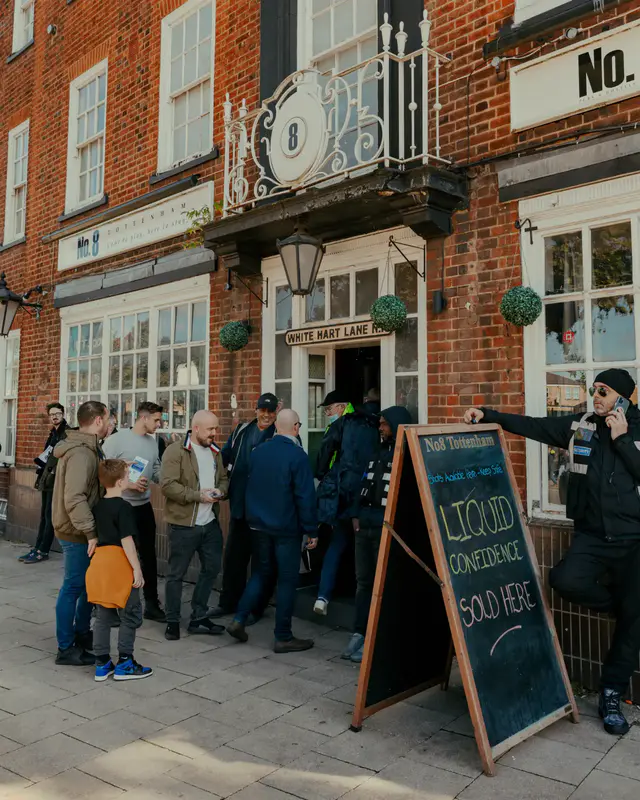MA// BLOG
THE RITUALS LIVE ON: MATCHDAY SUPERSTITIONS IN 2025

Football is not just about 90 minutes on the pitch. It’s about what you do before, after and around the match that makes the whole thing mean something. For as long as fans have been filing through turnstiles, there’s been a set of little traditions and superstitions running alongside the actual game. The shirt you wear. The way you lace your shoes. The pint you sink at the same pub, at the same time, with the same people. It’s folklore: not written in programmes or club histories, but carried on by fans themselves.
But what about the match-going youth of today: are Gen Z football fans engaging in the same rituals? The short answer is yes. The long answer
is that rituals have changed shape, but they’re still stitched into matchdays in ways that make football feel like something bigger than just results, sponsorship deals and post-match interviews. For some, it’s still the classic superstition, like never washing a scarf that “saw” a promotion season, or wearing the same socks every time your team plays at home. These things are not logical. Everyone knows they don’t really influence what happens on the pitch (or do they?). Anyway that’s not the point. Stuffing a vintage away shirt in your coat pocket every game because you did it by accident once and you won 5-0 is what makes you feel connected to the action. It turns a game into a rite, and that rite creates belonging.

Take the clothes. Terrace fashion has always been about more than just looking sharp. It’s also about repetition, habit, superstition. A lot of older fans still have one lucky jacket or shirt that comes out on matchdays, and you’ll hear the same from younger lads now, only these days it might be a Stone Island overshirt (or a Marshall Artist jacket) that you “won’t risk” swapping out if the team’s on a winning run. Jeans, trainers, jackets, hats: the outfit can feel like armour. You wear it the same way each week because it feels wrong to change it. In a game where you can’t control much, you control that.
But it ain’t just about clothes. Whole afternoons are built on rituals. The classic one is the pub: meet the same mates in the same place, drinks the same number of pints before the game, then get a burger or a pie from the same van for the same amount of cash (not card) and shrapnel. These spots are just as important as the stadium. Fans still talk about them like holy ground. Younger fans have picked this up too, though now it might be more about sending the same message on the group chat, drinking the same non-alcoholic beer and then filming a similar TikTok outside the ground. Whatever works for you.

Superstitions can also be weirdly specific. Some fans refuse to sit in a certain seat because they saw their team lose heavily from there once. Others have a set playlist they listen to on the drive to the ground, starting with the same song every time. A mate of mine won’t watch his side take a penalty in person. He says the team score more when he turns his back. Does he know that’s not statistically true? Of course. Will he ever risk breaking the routine? Not a chance. Either way, he should try supporting a team who never gets awarded penalties because the refs are all out to get them (like mine).
And then there’s food. Lower-league terraces are still full of people who’ll tell you they can’t go without their half-time hot dog, or that they’ll always grab a certain chocolate bar on the way to the ground. It’s the sort of thing you only notice if you stop doing it. Miss one week and the team loses, and suddenly you’ve jinxed it. Back you go to the routine next match, convinced you’re doing your bit. That’s the thing about superstition: it makes you part of the effort, however irrational it seems.

Of course, rituals change over time. The old days of wearing the exact same shirt for 20 years — holes, beer stains and all — have softened into a new kind of superstition. Modern fans are just as likely to rotate between a few retro shirts depending on the fixture: a 90s away kit for the big games, a special anniversary edition when the team’s struggling. It’s still ritual, just expressed differently. The core idea is the same: you’re trying to give your club a nudge of luck, however small.
Away days deserve their own chapter in this. For plenty of fans, the journey itself is ritualised: the early train, the cans of increasingly warm lager on the way, the same chant starting up in the same carriage. Away ends are where superstition really thrives. Some fans won’t travel to certain grounds because they’ve “never seen us win there.” Others insist on always being in the same block, as close to the pitch as possible, to “make sure the lads hear us.” The science behind it is shaky. The conviction is unshakeable.
So do young fans still believe in all this? Definitely. They just dress it differently. You’ll still find the lad who won’t change his socks during a winning run. You’ll still see the group who always meet outside the same turnstile, at the same time, week in week out. What’s changed is the context. Now it might be a voice note in a WhatsApp group instead of a pint in the same snug corner of the pub. But the principle remains the same: ritual turns football into something personal.





